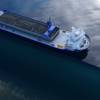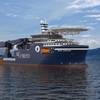Meet the Future of Marine Firefighting
Kongsberg, Robert Allan drive the future of marine fighting. The first vessel in the series will be the 20 meter RALamander 2000, featuring FiFi1 capability, pumping capacity of 2400 m3/hour and with optional foam capabilities.
Vancouver based naval architects and marine engineers Robert Allan Ltd., and international marine technology specialist Kongsberg Maritime are collaborating on the development of a radically new remotely-operated fireboat that will allow first responders to attack dangerous port fires more aggressively and safer than ever before. Like other autonomous efforts underway on the waterfront, this concept tackles and solves the so-called “3D’s” – dull, dirty and dangerous – of workboat drudgery.
The concept began as Kongsberg and Robert Allan Ltd jointly responded to a number of inquiries for other type unmanned workboats requiring a communications solutions based on Kongsberg's Marine Broadband Radio (MBR) system. The fruit of those labors is the RALamander.
According to Vince den Hertog, RAL’s Vice President of Engineering, the project that plays well to the respective strengths of both firms, given Kongsberg's strong background in offshore DP, sensing and communications and Robert Allan Ltd's track record with designing fireboats for service all over the world. Den Hertog explains, “Philosophically, we are also on the same page as far as setting realistic expectations for our clients and ourselves. We see autonomy being an incremental process and are both focused on practical solutions using best available technology, not autonomy for its own sake within a more futuristic vision.”
The Future of Marine Firefighting Unveiled
The un-crewed RALamander fireboat will offer in-close firefighting and ‘eye in the fire’ capability that keeps marine firefighting professionals out of harm's way. Fires involving containers, petrochemicals, shore-side structures or vessels can be attacked more quickly in situations where toxic smoke or explosion risk may delay or even prevent manned assets from responding effectively. RALamander can serve as a force multiplier with conventional firefighting assets, or be deployed on its own.
Ultimately, the goal is to have one remote control system for both the vessel and the firefighting equipment. Together with dynamic positioning, one person should be able to control the complete vessel/operation. And, says den Hertog, in the future, one person should be able to control multiple RALamanders.
The Kongsberg Maritime control & communications system will feature a robust high-bandwidth, low latency wireless link to a semi-portable RALamander operator console that can be located on a manned fireboat, or other vessel of opportunity such as a tug or pilot boat. In common with other KONGSBERG autonomous control systems, the versatile architecture of RALamander’s control system will leave the door open to a range of autonomy levels, which are configurable or future-upgradable to suit the operator or port’s evolving needs.
The MBR, which is the primary communication link, has a range beyond line-of-sight. Combined with a land based internet link, the theoretical distance is unlimited. Sondre Larsson, Kongsberg’s Sales Manager / Autonomy, explains, “We see it natural to start with a line-of-sight operation. When the functionality for more autonomous operation is installed, the operator/supervisor can be located anywhere. The experience from the first, purely remote controlled, RALamander will decide the path towards fully autonomous firefighting.”
RALamander 2000
With a total pumping capacity of 2400 m3/hour, the vessel’s retractable mast can bring one of the three monitors to a high point of attack for shipboard or dock fires and it also can lower the air draft profile. Still, some fires need to be fought in littoral / estuary situations. Hence, the navigational draft is just 3 meters. Den Hertog told MarineNews, “The propellers will be protected from impact with the bottom by the nozzles, and while there is no guarantee than choking by debris can't happen, our experience with shallow draft tugs with similar arrangements operating in debris-laden rivers is that the arrangement is simple and reliable for this application.” Moreover, waterjet propulsion is also an option, if a client prefers it.
The onboard powering system is diesel electric with batteries. Propulsion is by twin propellers in nozzles with separate bow and stern thrusters, all electrically driven. The two diesel gensets will be typically be IMO III compliant but this may depend on where RALamander will operate.
A range of auto functions is planned for firefighting, including dynamic positioning, water spray target holding, and ‘line protection’ where RALamander automatically moves back and forth along a line while directing protective spray cover on shore structures or vessels threatened by a fire. A low-profile design also makes it possible to attack under-wharf and marina fires remotely. If a burning vessel poses a threat to its surroundings, RALamander can be used to tow it a safe distance by means of its Grapnel Emergency Towing (GET) system.
Designing to a New Standard
Since RALamander can be operated from a safe stand-off distance during an incident, commercial entities such as tug or pilot boat operators may be in a better position to offer fire protection services to a port since personnel are less exposed to risks. That’s because, without crew-related accommodations, domestic systems or safety equipment, to worry about, there is more flexibility to optimize the overall hull dimensions to suit the speed and fuel requirements and place mission-related equipment like fire monitors, crane manipulators where it can be most effective. The retractable mast monitor on RALamander is a perfect example. Because there is no deckhouse or wheelhouse in the way, the placement and installation of this device is straightforward.
Allowing first responders to attack dangerous port fires more aggressively and safely is the most obvious benefit of this new vessel design. With that in mind, Marine News asked if the new vessel would also need to be built more robustly in terms of being able to withstand tougher, hotter, more perilous situations.
“Not the physical vessel,” insists RAL’s den Hertog. He continued, “It is typically human safety considerations like heat and smoke that limit the operation of conventional, manned fireboats when fighting fires, not the physical robustness of the boat itself. In other words, the boat itself can typically take a bit more than the people on it. Windows are always a potential weak spot on manned fireboat especially with an explosion risk, but these are eliminated on RALamander right off the bat. For protection against heat, RALamander will be protected by water spray much the same as a conventional fireboat. That said, sensors, communications antennas and cameras will need to be suitably rated and/or housed, but this is straightforward engineering.”
Of course, careful thought needs to go into the installation of communications and sensing equipment, cameras, lighting and so forth. Onboard machinery also has to be reliable enough for unmanned operations, but is worth noting that many large complex tugs already operate today with no engineer on board. And says Kongsberg’s Larson, “In any case, with RALamander, shoreside maintenance will be possible between sorties. RALamander will not be operating 24/7.”
Built-in Affordability
With maximum flexibility built into the design from the start, the RALamander series will offer all the advantages of remotely-operated fire response in a customizable system to suit a port’s needs for capability and cost. But, can today’s domestic cash-strapped municipalities afford such a tool? RAL and Kongsberg say that they can.
Like any new design concept, there are trade-offs and cost differentials. When considering a standard (manned) fireboat and this version, the end-user might pay a premium for the control system, but also achieve savings in other areas. RAL’s den Hertog agrees. “Yes, that is exactly the situation. There are capital cost savings from dispensing with the deckhouse, wheelhouse, domestic systems or lifesaving equipment, but there are offset by a premium for electronics, communications, sensing and operator console equipment to operate remotely. In the end, the cost difference will not be prohibitive since the capital cost of the vessel remains driven mainly by hull structure and major equipment/machinery. In any case, it's difficult to make apples-to-apples comparison between RALamander and a manned fireboat because they don't necessarily serve is the same roles.”
For example, and in port service, manned fireboats are often tasked not only with firefighting, but also with rescue and medical service which RALamander cannot provide. On the other hand, RALamander is able to fight fires that are too dangerous for a manned fireboat, or respond in CBRNE (Chemical, Biological, Radiological, Nuclear, Explosive) events if a fireboat is not equipped for it. While some fireboats in major US cities like New York, Long Beach California and Seattle are CBRNE-equipped, the cost & complexity of the special equipment and arrangements required such as air locks, military-grade air filtration and citadel pressurization systems, and redundant detection are considerable. “RALamander needs none of these things and can respond immediately in a CBRNE event, even sacrificially if necessary,” explains Kongsberg’s Larsson, adding quickly, “So, we see don't see RALamander necessarily replacing manned fireboats in a port setting, but working with them as a force multiplier. Offshore firefighting is another excellent application for RALamander.”
A Look Ahead: What’s Next?
Over time, Vancouver-based Robert Allan Ltd. (RAL) has emerged as a leader in developing high-performance response vessels of many types, but particularly fireboats for many of the world’s major ports. For its part, Norway-based Kongsberg Maritime is a global marine technology company providing solutions for all marine industry sectors. The firm’s products and systems include all aspects of marine automation, safety, maneuvering, navigation, and dynamic positioning, communication and camera systems, among many others. Together, the two firms constitute a robust and proven team, fully capable of this kind of high-tech endeavor.
According to both RAL and Kongsberg, the concept has certainly generated interest and the partners report having “some irons in the fire with regard to the first customer.” With well over one thousand of their tugs and other workboat designs built to date, Robert Allan Ltd has established long-standing close working relationships with shipyards around the world. And, says Vince den Hertog, “A first vessel built on speculation is a distinct possibility.”
(As published in the June 2018 edition of Marine News)













